|

|
|
|
21.4 Development of the internal genital organs
|
|
|
In females: Differentiation of the canal system in the genital organ
|
|
|
|
During the 7th week the canal system of the female sex organs differentiates. The mesonephric duct and its tubules atrophy and out of the paramesonephric duct (Müller) arises the future fallopian tube, the uterus and the upper part of the vagina.
Sometimes, a few embryonic remnants of the mesonephric duct remain in the form of the epoöphoron, the paroöphoron at the level of the mesovarium, and a row of small cysts of Gartner.
Out of the upper, non-fused portion of the paramesonephric duct (Müller) arises the fallopian tube and its ampulla. The lower section fuses after it crosses medially on both sides of the inferior ovarian gubernaculum and forms the utero-vaginal canal. The medial septum in between disappears at the end of the 3rd month.
|
|
|
Reminder
|
|
Scheme showing the molecular factors involved in the development of the sexual apparatus
|
|
|
| Fig. 42 - Differentiated female sex organs, ca. 4th month |
|
Legend |
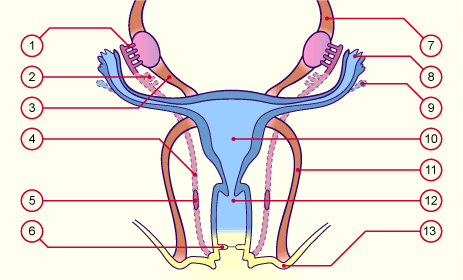
1
2
3
4
5
6
7
8
9
10
11
12
13 |
Epoöphoron
Paroöphoron
Ovarian ligament
Atrophied mesonephric duct (Wolff)
Cysts of Gartner
Hymen
Suspensory ligament of ovary
Fallopian tube (ampulla)
Vesicular appendage (Morgani)
Uterus
Round ligament of uterus
Vagina
Insertion of the round ligament of uterus at the genital swelling |
|
|
|
Fig. 42
Shown is the atrophied mesonephric duct (Wolff) that, however, leaves certain embryonic remnants behind. Out of the paramesonephric duct (Müller) arise on both sides the fallopian tubes and through fusion of both sides the uterus and the upper part of the vagina (blue). The lower part of the vagina (yellow) comes from the urogenital sinus (endoderm). To be noted is also the development of the ligaments and the hymen, the middle part of which usually disintegrates at around the time of birth.
|
|
Overview
|
|
Table for comparing the differentiation of the internal sex organs in both sexes
|
|
|
|
|
To be observed is the development of the ligaments. The ovarian gubernaculum gets attached on the developing utero-vaginal canal there where it goes over into the fallopian tube. Above it forms the ovarian ligament and below the round ligament of uterus, which goes through the inguinal canal and inserts in the female genital swelling (labia majora).
If the separating wall beyond the fusion location of the two paramesonephric ducts is not resorbed, various utero-vaginal abnormalities result. |
|
Fig. 43 - Formation of the uterus,
7th – 8th weeks |
|
Legend |
|
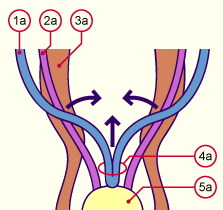
|
|
Fig. 43
Up to the 7th week two canal systems on each side exist in both sexes. In the 8th week the paramesonephric ducts (Müller) fuse in the lower portion after they have crossed medially on both sides of the mesonephric duct (Wolff).
|
Fig. 44 - Formation of the uterus
after 8 weeks |
|
Fig. 45 - Formation of the uterus
ca. 3rd month |
|
Legend |

1a
2a
3a
4a
5a
|
Paramesonephric duct (Müller)
Mesonephric duct (Wolff)
Lower gubernaculum
Utero-vaginal canal
Urogenital sinus |
|
|
|
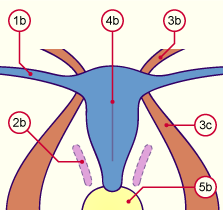
1b
2b
3b
3c
4b
5b
|
Fallopian tube
Atrophied mesonephric duct (Wolff)
Ovarian ligament
Round ligament of uterus
Uterus
Vagina |
|
|
|
Fig. 44
Formation of the utero-vaginal canal through fusion of the lower section of the two paramesonephric ducts (Müller). From the upper section - on both sides - arise the fallopian tubes with their ampullae.
Fig. 45
At the end of the 3rd month the separating wall dissolves in the uterus and the vagina. The uterus lengthens in that the solid lower end of the paramesonephric duct stretches in a downward direction and is subsequently canalized. Out of the lower section arises the upper part of the vagina. It joins with the vaginal lamina, which arises from the urogenital sinus and forms the lower portion of the vagina.
|
|
The blind end of the utero-vaginal canal forms the sinu-vaginal eminence  22 22 and ends at the back wall of the urogenital sinus (SUG). and ends at the back wall of the urogenital sinus (SUG).
The sinu-vaginal eminence becomes thicker due to epithelial proliferation and retracts, while the wall of the SUG also thickens there. These epithelial layers, which form at the lower end of the utero-vaginal canal, are known as the vaginal plate. At their cranial end they form a circular protrusion, the location of the future vaginal fornix.
|
|
|
Fig. 46 - Female sex organs
ca. 7th week |
|
Fig. 47 - Female sex organs
ca. 12th week |
|
Legend |
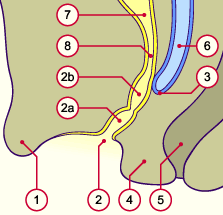
1
2
2a
2b
3
|
Genital tubercle
Vestibule
Urovaginal sinus: pelvic part
Urovaginal sinus: phallic part
Vaginal plate |
|
|
|
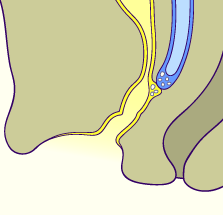
4
5
6
7
8 |
Perineum
Rectum
Utero-vaginal canal
Urinary bladder
Urethra |
|
|
|
Fig. 46
The utero-vaginal canal comes up against the urogenital sinus and forms the sinu-
vaginal eminence.
Fig. 47
This sinu-vaginal eminence becomes thicker due to epithelial proliferation. This also leads to a epithelial proliferation in the SUG epithelium. Together they form the vaginal plate.
|
Through canalization of the vaginal plate the utero-vaginal canal opens itself towards the outside. The upper 3/4 of the vagina comes from the mesoderm and the lower fourth from the endoderm.
The fibromuscular walling forms from the neighboring mesenchyma. The vagina is separated from the SUG by the hymen. Its origin is not entirely clear. Discussed is a passive invagination of the back wall of the SUG. |
|
Fig. 48 - Female sex organs
ca. 3rd month |
|
Legend |
|
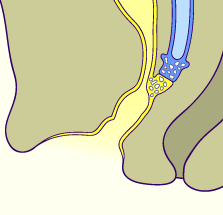
|
|
Fig. 48
The canalization of the vaginal plate begins in the 3rd month.
|
Fig. 49 - Female sex organs
ca. 5th month |
|
Fig. 50 - Female sex organs
ca. 9th month |
|
Legend |
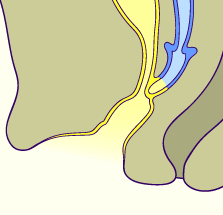
|
|
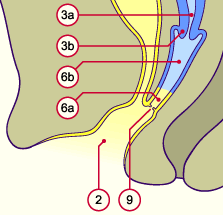
2
3a
3b
6a
6b
9
|
Vaginal vestibule
Uterine cavity
Uterine cervix (neck)
Vagina: The lower fourth out of
endoderm
Vagina: The upper 3/4 out of
mesoderm
Hymen |
|
|
|
|
Fig. 49
In the 5th month the vaginal canal is completely canalized, but the lumen is separated from the SUG by the hymen.
Fig. 50
Normally, the hymen tears open at the time of birth. The uterus and the vagina then have a connection to the vaginal vestibule.
|
|
|
|
|
|

